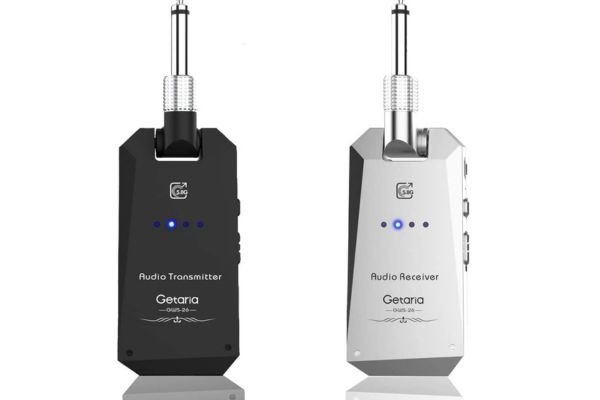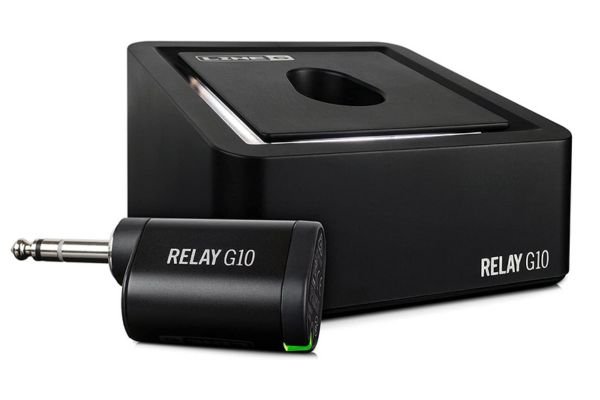Annoyed with tangy wires while performing? Go wireless! But the best wireless systems can be expensive; some are way too pricey (over $600). Thanks to wireless system manufacturers like Xvive or NUX for producing some budget wireless systems that do not compromise quality. To introduce to you those best wireless systems, here I am sharing my list of 5 best cheap wireless guitar system that comes with top-notch quality while being affordable. What’s the point of waiting? Let’s get them!
List of best cheap wireless guitar system
1. Xvive U2 Guitar Wireless System (Best Overall)
Key Features
- Channel: 4
- Latency: Less than 5ms
- Item Weight: 3.52 ounces
- Product Dimensions: 7.48 x 3.94 x 1.97 inches
The Xvive U2 uses a 2.4GHz digital wireless technology that provides a stable signal up to 120 feet! This wireless system delivered a clear tone without any noticeable noise even when I was around 70 feet away with two walls between me, thanks to its wider frequency. Its built-in batteries provide up to 5 hours of playtime on a single charge, and here I think the Xvive could do a bit better. Featuring a frequency response of 20Hz-20kHz and less than 5 milliseconds latency, it delivers tone with minimal signal loss. Its solid sound quality, range, and latency performance make it a clear winner in my top 5 list.
Pros
- Offers clear sound that captures every nuance
- Match transmitter and receiver by pressing a signal key
- Compact and lightweight transmitter
- Rechargeable batteries
- 30 days money back guarantee with 1-year warranty
Cons
- Does not work with active pickup guitars
2. NUX B-5RC Wireless Guitar System (Best Battery Life)
Key Features
- Channel: Automatic
- Latency: Less than 5ms
- Item Weight: 8.8 ounces
- Product Dimensions: 5.3 x 3.15 x 1.96 inches
With a stable signal of 5.8GHz digital wireless technology and a range of up to 100 feet, the NUX B-5RC is designed to give you the freedom to move around. NUX claims that the batteries can last up to 9 hours of playtime on a single charge, and I’ve used it for 7 hours without any issues. You can enjoy a crisp and clear sound with low latency (less than 5 milliseconds) and a frequency response range of 20Hz-20kHz. Besides, the B-5RC simplifies the process by automatically detecting the best channel for you.
Pros
- High-quality audio without distortion
- Switching guitars or pedals is fast and easy
- Inbox charging can charge the system around 3 times
- Less prone to interference
- Rechargeable batteries
Cons
- Shut down automatically if there’s no signal for 10 minutes
3. Getaria Upgrade 2.4GHZ Wireless Guitar System (Best For Fast-charging)
Key Features
- Channel: 4
- Latency: Less than 5.6ms
- Item Weight: 8.1 ounces
- Product Dimensions: 5.6 x 1.7 x 0.6 inches
Like NUX, Getaria Upgrade also comes with a 5.8GHz wireless system and frequency response of 20Hz-20kH, providing high-quality audio. Lithium-ion batteries awake the system for up to 8 hours of playtime on a single charge! Even after using it for 7 hours, I didn’t get a low battery sign, and on top of it, you can recharge it in just 1.5 hours! Also, the Getaria has a standard range of 100 feet, and I didn’t get signal loss thanks to its low latency of less than 5.6 milliseconds.
Pros
- High-quality audio output with standard signal transmission
- Auto-pairing transmitter and receiver
- Fast-charging in 1.5 hours
- Rechargeable batteries
Cons
- Power LED isn’t visible if plugged into the side of the guitar
4. Line 6 Relay G10 Digital Wireless Guitar System (Best For Indoor Use)
Key Features
- Channel: Automatic
- Latency: Less than 2.9ms
- Item Weight: 1.7 pounds
- Product Dimensions: 9.1 x 3.5 x 14.4 inches
Line 6 operates on a 2.4GHz wireless technology, and the 24-bit signal transmission provides clear sound. With the 50 feet of range, it is best for indoor use. The thing I liked about it is the ‘pop’ free plug. It means there won’t be any sound while inserting or pulling out the dongle. It has a battery backup of 6 hours on a single charge and has the lowest latency among my top 5 (less than 2.9ms).
Pros
- Auto-pairing transmitter and receiver
- Really low latency
- Bright LED recharge indicator
- Rechargeable batteries
Cons
- No on/off switch
5. LEKATO Wireless Guitar System Wireless Guitar
Key Features
- Channel: 4
- Latency: Less than 6ms
- Item Weight: 6.3 ounces
- Product Dimensions: 6.69 x 4.33 x 1.77 inches
The LEKATO uses advanced wireless technology of 5.8GHz frequency and operates at a standard frequency response of 20Hz-20kHz. Although the brand claims a battery life of up to 5 hours, I found it to work at most 4 hours on a single charge. Its impressive range of up to 100 feet, like NUX and Getaria, and low latency of less than 6ms let you move freely without worrying about signal dropouts.
Pros
- Broad range of sound without distortion
- Transmitter & receiver sync up really fast
- Fast-charging feature
- Rechargeable batteries
Cons
- Difficult to distinguish the receiver and transmitter
- The construction is all plastic except the metal plug
Are Wireless Guitar Systems Reliable?
In the past, there were some issues with interference and signal dropouts in wireless systems. But today, the latest wireless guitar systems use advanced digital signal processing and frequency technology to minimize interference and ensure a stable connection. These advanced technologies with really low latency decrease signal loss to nearly zero, and the standard frequency response and wireless technology ensure that your sound remains strong and clear.
Are Wireless Guitar Transmitters Worth It?
Wireless guitar transmitters are definitely worth it. With a reliable wireless system, you’re free to move around the stage and engage with your audience – that kind of connection is priceless. A quality wireless guitar system with advanced signal transmission technology eliminates interference and ensures your tone is clean, clear, and true to your unique style.
On top of it, a wireless system is compact, lightweight, and easy to set up, and investing in a wireless system can also save you money in the long run. While the initial cost may seem high, over time, you’ll be saving money on cable replacements and repairs, which can add up quickly.
How To Choose The Best Wireless Guitar System?
1. Wireless Technology:
GHz implies the frequency of waves your device uses that transmit and receive the Wi-Fi signals. Look for a wireless system with a wireless technology of 2.4 GHz or 5.8 GHZ.
Why Is Considering Wireless Technology Important?
Quality wireless technology saves you from frequency interference in crowded wireless environments (large concert halls), even if multiple wireless devices are on the same frequency band. It also ensures you don’t get a signal loss or poor sound quality.
2. Battery Life:
How much battery life is needed depends on your wireless system use. A battery life of around 3-4 hours is enough for indoor use, as you can easily recharge the system during breaks. For outdoor use, you’ll want to look for a system with a longer battery life of at least 5-6 hours so that you can play for a long time without worrying about recharge.
Why Battery Life Is A Priority In Wireless Guitar Systems?
With a wireless system that offers long battery life, you won’t have to worry about charging batteries mid-performance. A system with long battery life or, even better, rechargeable batteries that last for hours on a single charge gives you true wireless freedom!
3. Latency:
Latency means the delay between playing a note and hearing it through the amplifier. Choose a system with low latency (at most 6ms), so there’s a minimal delay.
Why Is Low Latency Is Important?
Even a slight delay of a note can ruin your timing and rhythm. But a quality wireless system with low latency decreases the delay between playing and hearing a note. Ultimately, the low latency ensures that you can play accurately and in proper sync.
4. Range:
If you are thinking of a wireless system for outdoor use, go for a range of at least 90-100 feet to have plenty of room to move around. 50 feet of a range is good enough for indoor use.
Why Should You Go For Wide Range?
A system with a wide range gives you plenty of space to move without worrying about losing your connection. Plus, having a good range helps prevent signal interference and dropouts.
5. Frequency Response:
Frequency response refers to how accurately a piece of equipment can produce high-pitched or low-pitched sounds and everything in between. Ideally, a system with a frequency response of 20Hz to 20kHz can cover the full range of human hearing, and that’s enough.
See Also: Best Semi Hollow Guitars Under 1000
Is Frequency Response Really Important?
A guitar produces a wide range of frequencies, from the low end of the bass strings to the high end of the treble strings. If your wireless system can’t accurately reproduce the full range of frequencies your guitar produces, you may lose the subtleties of your playing. It’ll result in a muddier or less defined sound. A system with a wide frequency response will ensure that your wireless system can accurately capture and transmit all the frequencies your guitar produces.
Final Words
The best cheap wireless guitar system gives you the freedom to move around on stage and eliminates the hassle of dealing with cables and cords. With crystal-clear sound quality and reliable connectivity, the best cheap wireless system can give you true wireless freedom. You can rock out on stage or jam in your bedroom without worrying about range or battery life. Break free cables and let your music soar.





